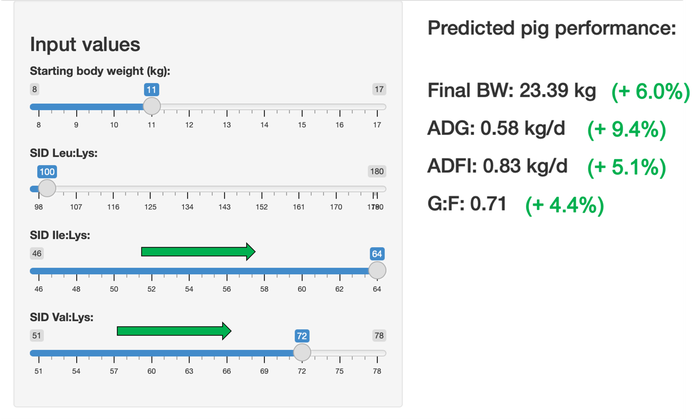Understanding branched chain amino acid ratios in nursery pigs
Identifying optimal levels of leucine, isoleucine and valine in nursery pig diets will depend on ingredient availability, cost and growth metric optimized.
June 22, 2023

By Dalton Humphrey and Laura Greiner, Iowa State University
Leucine, isoleucine and valine, known as the branched-chain amino acids, are dietary essential amino acids in swine. With the availability of feed-grade L-valine and L-isoleucine, levels of these two amino acids in swine diets are typically close to the proposed requirement of the pig.
The inclusion of dried distiller's grains with solubles typically results in the leucine concentration in the diet being in relative excess. However, due to shared steps in the pathway of BCAA catabolism, excess consumption of one or two BCAA will increase the catabolism of all three BCAA, which may result in marginal deficiency and negatively impact growth performance.
Previous research with nursery pigs has largely focused on evaluating valine and isoleucine requirements. However, there is a lack of data evaluating all three BCAA or their interactions in nursery pigs, which may have important implications when determining the requirements of BCAA separately. The NRC (2012) requirements for 11 to 25 kg pigs are 100%, 51% and 63% for SID Leu:Lys, Ile:Lys, and Val:Lys, respectively, but these recommendations may not be consistent when diets contain unbalanced levels of BCAA.
A study was conducted at Iowa State University to evaluate the impact of leucine, isoleucine and valine interactions on the growth performance of 10 to 20 kg nursery pigs. On day 21 post-weaning, 80 pens of six pigs were randomly assigned to one of 15 diets arranged in a central composite design. The diets were formulated to contain various SID leucine, isoleucine and valine levels such that the SID BCAA:Lys levels in the diets ranged from 98 to 180% for leucine, 46 to 64% for isoleucine and 51 to 78% for valine. Pigs were on study for three weeks and the measurements of average daily gain, average daily feed intake and feed efficiency were collected.
Feeding a valine:lysine ratio of 70 optimized pig gain and feed efficiency during the three week study. There was an interaction between Leu and Ile, where increasing both Leu and Ile negatively impacted growth and efficiency. Reducing either Leu or Ile while the other remained elevated improved pig performance. Increasing Leu in the diet negatively impacted feed intake at low levels of Val but did not influence feed intake at levels of Val at or above the NRC (2012) recommendation. Based on the models developed in this study, growth performance is predicted to improve by approximately 4.5 to 9.5% by increasing the SID Ile:Lys and Val:Lys in the diet from NRC (2012) recommendations.
From the data collected from the study, regression equations were developed that can be used to predict growth performance of nursery pigs in response to differing levels of BCAA in the diet; however, with all empirical models, caution should be taken when extrapolating model parameters outside the ranges evaluated in the study (Table 1).
Figure 1 is an example of a performance prediction tool that is being developed by the research team at Iowa State to be used by nutritionist for determining optimal BCAA levels. This prediction tool will help nutritionists predict growth and performance based upon the BCAA levels.
Identifying the optimal levels of leucine, isoleucine and valine in nursery pig diets will depend on ingredient availability, cost and which growth metric is being optimized. However, it is important to note that there is flexibility in BCAA optimization, where similar growth performance is predicted to occur at various levels of leucine, isoleucine and valine.

Figure 1. Predicted improvements in nursery pig growth performance through altering BCAA ratios compared to NRC (2012) recommendations.
This project was made possible through funding by CJ America – Bio.
You May Also Like
.png?width=300&auto=webp&quality=80&disable=upscale)


